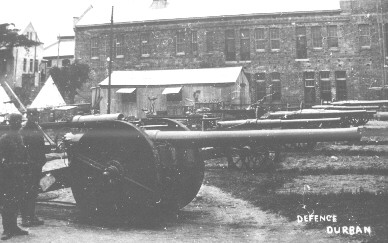Heavy British Artillery
British 4,7" Naval Guns

These heavy guns were also called "cow guns" because they were so heavy they had to be drawn by oxen. The guns were initially removed from the British warship, HMS Terrible, and were intended to match the Boer Long Toms since the British did not possess any field artillery which could compete with the Boer siege guns. Where they could be used, they proved to be frightful weapons. Their one problem was that for long range shots, the 4,7's could only be loaded with lyddite shells, intended for piercing forts and armour plating. Lyddite left massive bomb-craters, but the effect of the explosion was limited to only the immediate surroundings. The Boers frequently reported that however frightful the noise produced, the 4,7's seldom caused them extreme distress. Photo source: National Archives of South Africa.

4,7 at the Tugela front in Natal.
The big problem with the 4,7" guns was the fact that they were so heavy that it was difficult to move them. The oxen which were used in the gun teams were strong enough to pull the weight, but they were much slower than horses or mules. At the Tugela front, some 4,7's were mounted on wooden platforms, in stead of wheels. Photo source: National Archives of South Africa.

A 4,7" gun at the Tugela front in Natal. General Clery standing with binoculars on the right. Photo source: National Archives of South Africa.
The mobile 4,7's had steel wheels that were homemade at short notice, and which were somewhat unusual for the time. Sometimes holes were dug at the rear of the guns in order to lift the barrels and obtain a greater elevation, which would increase the range of the guns.
The 4,7" guns weighed just over two tons, and with a fully-loaded ammunition carriage, the entire outfit weighted a shade over 6 tons. Because of the immense weight, the 4,7's couldn't not be moved fast enough in order to deal with changing battlefield situations. They also presented many problems in soft ground, or during the crossing of fords, when the wheels got stuck and caused serious delays. For this reason the 4,7's were not used as extensively as the army would have liked.
What made them valuable was their formidable range. The 4,7's could send a 5,7kg projectile between 4 and 7,3 km, which was often just what was needed in order to reach Boer artillery in awkward spots, or to simply drill around on the hills in search of distant trenches. Nevertheless, the range could still not quite compare with the Boer Long Toms, and the naval gunners were glad that the Boers had only four Long Toms to deal with.

A 4.7" gun mounted on a howitzer carriage in order to save weight.
British 12-pounder Naval Gun

Originally taken from the HMS Terrible, these guns were popularly known as "Long 12's." The fact that this gun had been taken from a warship, can be seen from its makeshift wooden gun carriage. These were constructed in haste, often using the front wheels of waggons, so that the guns might be dragged afield. The 12-pounders were much more mobile than their bigger brothers, the 4,7 inch "cow-guns," yet they packed a powerful punch and had a fairly long range.
The long 12's weighed just over 600 kg, without the ammunition carriages. Shell and shrapnel weights were 5,7 kg respectively, which is to be expected for such a powerful gun. Their range was approximately 4 to 7,3 km.

According to information kindly contributed by MC Heunis, the "Officier van adminitratie" of the "Oranje Vrijstaat Artillerie Corps," Thise guns is a 5 inch 40cwt breechloading gun of the Royal Garrison Artillery, and as such, it is not a naval gun. There are two of these guns on display in front of the Union Buildings in Pretoria. They are mounted on 40 pounder RML carriages, which were also used for the 6.3 inch RML howitzer. Both guns were used by the 16th Battery RGA. They were also used against he Boer Long Toms at the Long Tom pass between Sabie and Lydenburg in the Eastern-Transvaal. The guns have been restored since these pictures were taken. Here are the new pictures.
Home-built "Long Cecil"

This gun, nick-named "Long Cecil" was built in Kimberley by the De Beers engineers during the siege. It was built in an effort to strike back against the more powerful Boer artillery, which could not be reached with Colonel Keckewich's artillery. Long Cecil was named after the millionaire diamond magnate and chairman of the De Beers company, Cecil John Rhodes, who had chosen to join the siege earlier on.
Photo credit: The South African National Archives.

This picture shows the breech of Long Cecil. The construction was of simple, yet effective design.
Photo credit: The South African National Archives, TAB28113.

Long Cecil today stands in front of the Honoured Dead Memorial in Kimberley.
Photo: H. Labuschagne 1999.

Maxim-Nordenveldt TAB19903
British 37mm Maxim-Nordenveldt "Pom-Pom." This picture probably dates from the latter part of the war. Notice that this one does not have an armour shield, as was often fitter later on in order to protect the gun crew.

British artillerymen shelling General De Wet's burghers at Doornkop, near Lindley.

Armchair historians--and also many generals--often made the mistake of studying maps and imagining that armies and war supplies could simply be moved across the map as simply as removing a flag pin and sticking it somewhere else. In reality the African landscape was harsh and deceptive above all things. Every stream and rivulet turned into a raging torrent after thunderstorms and soggy clay made fords unpassable for long periods of time. Artillery pieces are extremely heavy and run on narrow wheels. The result was that crossing rivers and vleis often presented major logistical nightmares, as this picture of a stuck artillery gun in a bog clearly indicates.
|